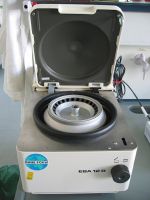Centrifuge
A centrifuge is a piece of equipment, generally driven by a motor, that puts an object in rotation around a fixed axis, applying force perpendicular to the axis. The centrifuge works using the sedimentation principle, where the centripetal acceleration is used to separate substances of greater and lesser density. There are many different kinds of centrifuges, including those for very specialized purposes. It can be used for viable counts, when shaking the culture e.g. yeast, out of suspension.
Theory
Protocols for centrifugation typically specify the amount of acceleration to be applied to the sample, rather than specifying a rotational speed such as revolutions per minute. The acceleration is often quoted in multiples of g, the standard acceleration due to gravity at the Earth's surface. This distinction is important because two rotors with different diameters running at the same rotational speed will subject samples to different accelerations.
The acceleration can be calculated as the product of the radius and the square of the angular velocity.
History and predecessors
English military engineer Laval (1707-1751) invented a whirling arm apparatus to determine drag, and Antonin Prandl invented the first centrifuge in order to separate cream from milk to make churning butter much easier.
Types and uses
There are basically four types of centrifuge:
- Tabletop/clinical/desktop centrifuge or microcentrifuge
- High-speed centrifuge
- Cooling centrifuge
- Ultracentrifuge
Laboratory centrifuge
Simple centrifuges are used in chemistry, biology, and biochemistry for isolating and separating suspensions. They vary widely in speed and capacity. They usually comprise a rotor containing two, four, six, or many more numbered wells within which the samples containing centrifuge tips may be placed.
Isotope separation
Other centrifuges, the first being the Zippe-type centrifuge, separate isotopes, and these kinds of centrifuges are in use in nuclear power and nuclear weapon programs.
Gas centrifuges are used in uranium enrichment. The heavier isotope of uranium (uranium-238) in the uranium hexafluoride gas tend to concentrate at the walls of the centrifuge as it spins, while the desired uranium-235 isotope is extracted and concentrated with a scoop selectively placed inside the centrifuge. It takes many thousands of centrifuges to enrich uranium enough for use in a nuclear reactor (around 3.5% enrichment), and many thousands more to enrich it to atomic bomb-grade (around 90% enrichment).
Aeronautics and astronautics
Human Centrifuges are exceptionally large centrifuges that test the reactions and tolerance of pilots and astronauts to acceleration above those experienced in the Earth's gravity.
The US Air Force at Holloman Air Force Base, NM operates a human centrifuge. The centrifuge at Holloman AFB is operated by the aerospace physiology department for the purpose of training and evaluating prospective fighter pilots for high-g flight in Air Force fighter aircraft. It is important to note that the centrifuge at Holloman AFB is unrealistic in that it is far more difficult for a pilot to tolerate the high-g environment in the centrifuge than in a real fighter aircraft. This well-known fact is based on countless accounts from experienced operational fighter pilots. [citation needed]
The use of large centrifuges to simulate a feeling of gravity has been proposed for future long-duration space missions. Exposure to this simulated gravity would prevent or reduce the bone decalcification and muscle atrophy that affect individuals exposed to long periods of freefall. An example of this can be seen in the film 2001: A Space Odyssey.
Commercial applications
- Standalone centrifuges for drying (hand-washed) clothes - usually with a water outlet.
- Centrifuges are used in the attraction Mission: SPACE, located at Epcot in Walt Disney World, which propels riders using a combination of a centrifuge and a motion simulator to simulate the feeling of going into space.
- In soil mechanics, centrifuges utilize centrifugal acceleration to match soil stresses in a scale model to those found in reality.
- Large industrial centrifuges are commonly used in water and wastewater treatment to dry sludges. The resulting dry product is often termed cake, and the water leaving a centrifuge after most of the solids have been removed is called centrate.
Calculating relative centrifugal force (RCF)
Relative centrifugal force is the measurement of the force applied to a sample within a centrifuge. This can be calculated from the speed (RPM) and the rotational radius (cm) using the following calculation.
where
- g = Relative centrifuge force
- r = rotational radius (centimeters, cm)
- N = rotating speed (revolutions per minute, r/min)
See also
- Centrifugation
- Gas centrifuge
External links
All links Retrieved December 1, 2007.
- RCF Calculator and Nomograph
- Centrifugation Rotor Calculator
- Selection of historical centrifuges in the Virtual Laboratory of the Max Planck Institute for the History of Science
Credits
New World Encyclopedia writers and editors rewrote and completed the Wikipedia article in accordance with New World Encyclopedia standards. This article abides by terms of the Creative Commons CC-by-sa 3.0 License (CC-by-sa), which may be used and disseminated with proper attribution. Credit is due under the terms of this license that can reference both the New World Encyclopedia contributors and the selfless volunteer contributors of the Wikimedia Foundation. To cite this article click here for a list of acceptable citing formats.The history of earlier contributions by wikipedians is accessible to researchers here:
The history of this article since it was imported to New World Encyclopedia:
Note: Some restrictions may apply to use of individual images which are separately licensed.

